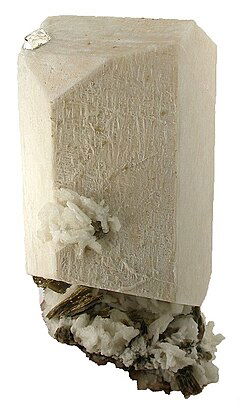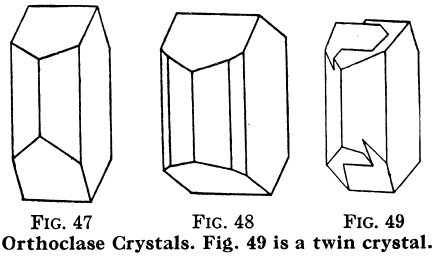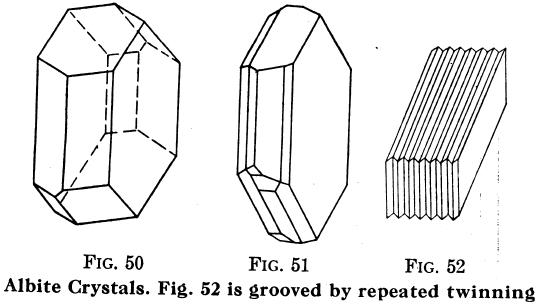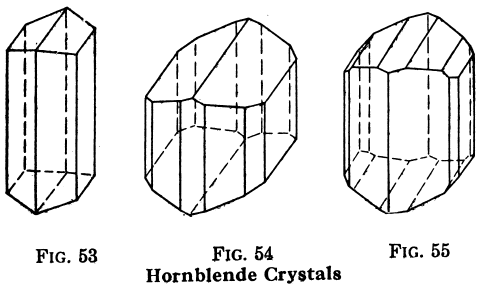Table of Contents
Feldspars constitute a group of similar minerals, which may be described as silicates of aluminum and either potash or soda or lime. Color, white, or pale shades of yellow, red, or green, sometimes gray; powder, white; luster, glassy; usually opaque; H = 6 to 6.5; G = 2.55 to 2.75; crystals, in the monoclinic system (orthoclase) or in the triclinic system (microcline, albite, oligoclase, andesine, labradorite, anorthite); cleavage, perfect, differing a little in two directions, which are at right angles in orthoclase, and which make an angle of nearly 90° in the other feldspars; good cleavage pieces of feldspar will thus show four smooth surfaces and two rough ones, so arranged that the smooth surfaces form four sides of a square or nearly square prism, of which the two rough surfaces are the ends.
Orthoclase
Orthoclase; KAlSi3O8.—Color, reddish, gray, white, pale yellow, rarely green; powder, white; H = 6 G=2.57; composition, silicate of aluminum and potash, and therefore a potash feldspar; contains 64.7% silica, 18.4% alumina (aluminum oxide), 16.9% potash, usually soda in place of a part of the potash.
Adularia & Sanidine
Adularia, is a transparent variety. Sanidine is a glassy, transparent or nearly transparent variety found in some volcanic rocks. Orthoclase is the common feldspar of granite and rhyolite.
Microcline
Microcline, has the same composition as orthoclase, but differs from it in having the edges made by its four cleavage surfaces a little off the square, about half a degree. Amazon-stone is a green variety.
Albite
Albite, NaAlSi3O8:, is usually white, as its name indicates (from albus, white); composition, soda feldspar; contains 68.7% silica, 19.5% alumina, 11.8% soda.
Oligoclase
Oligoclase a soda-lime feldspar; contains 62% silica, 24% alumina, 9% soda, 5% lime. Sunstone is a variety.
Andesine
Andesine is also a soda-lime feldspar, but with more lime and less soda; it varies in composition.
Labradorite
Labradorite has still more lime and still less soda; it is gray, brown, or greenish, and often shows a beautiful play of colors; composition about as follows: 53% silica, 30% alumina, 4% soda, 13% lime.
Anorthite
Anorthite CaAl2Si2O8, is a lime feldspar, contains 43% silica, 37% alumina, 20% lime.
Albite, oligoclase, andesine, labradorite, and anorthite are often called plagioclase feldspars, which refers to the cleavage, making edges about 4° off the square. Their crystals are nearly always grooved, due to twinning.
Note that labradorite and anorthite are much lower in silica than the others; this leads to a separation of the feldspars into two classes:
- (a) acidic feldspars, orthoclase, microcline, albite, oligoclase, and andesine, with 62% to 65% silica (characteristics of acid rocks, such as granite);
- (b) basic feldspars, labradorite and anorthite, with 43% to 53% silica (characteristics of basic rocks, such as diabase, diorite, etc.
In commercial quantity and condition, feldspar is found mostly in pegmatite dikes (coarsely crystalline granite).
It must be free from black mica, hornblende, tourmaline, and other dark minerals. The feldspar and the quartz are often crystallized in separate large masses, so that pure feldspar is easily quarried. Sometimes the two minerals are intergrown in a peculiar way, the quartz appearing like letters set in the feldspar, the so-called graphic granite. Feldspar containing a certain proportion of quartz is saleable; No. 1 contains less than 5% of quartz, No. 2 up to 15% or 20%, and No. 3, still higher, but not over 30%. Microcline and orthoclase are the varieties of feldspar commonly mined. Users prefer a potash feldspar, but the soda feldspar, albite, is used to some extent. Ground feldspar is used largely in the manufacture of pottery, partly to mix with the clay and partly as glaze; also, for the manufacture of enamels, door knobs, electrical insulators, opal glass, soaps, and polishes; it is likewise used as a bond in the manufacture of corundum, emery, and carborundum wheels, etc. The purest selected feldspar is used in the manufacture of artificial teeth (dental-spar). The lowest grades are used for roofings and artificial stone.
 During recent years ground nepheline syenite has largely taken the place of feldspar in the ceramic industries of the United States and Canada.
During recent years ground nepheline syenite has largely taken the place of feldspar in the ceramic industries of the United States and Canada.
Amazonstone is orthoclase or microcline of a beautiful green color; it is valuable for ornamental purposes.
